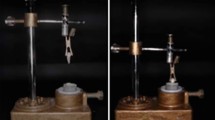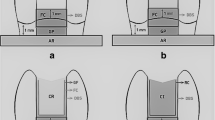Summary
Aim: This was to evaluate the effect of different thicknesses of cavity walls on fracture strength of pulpotomized primary molar teeth with class II amalgam restorations. Methods: 80 carious extracted human primary molar teeth were selected for pulpotomy preparation. The teeth were divided into four groups. Mesio- or disto-occlusal (20 teeth) and mesio-occluso-distal (20 teeth); cavities were prepared in both first and second primary molar teeth. Each group was divided into two subgroups of ten teeth according to the thickness of their walls (1.5 or 2.5 mm). After restoring teeth with amalgam, all groups were stored in distilled water at 37°C for seven days. They were then thermo cycled 1,000 times between 5° to 55°C. The specimens were then subjected to a compressive axial load in a universal testing machine at a crosshead speed of 0.5 mm min−1. The t-test was used for statistical analysis. Results: Mean fracture resistances of the first and second molar teeth were 975.5 ± 368.8 and 1049.2 ± 540.1, respectively. In the first molars, fracture resistance of 2-surface cavities was significantly more than 3-surface cavities (p=0.001), but this difference was not statistically significant in second molars. In second molars, fracture strength in 2- and 3-surface cavities with a 2.5 mm thickness in the walls was more than those with 1.5 mm thickness. However, in first molars this difference was only statistically significant in 3-surface cavities (p=0.045). Conclusions: The fracture strength in pulpotomized primary molar teeth with amalgam restorations was high, more than maximum bite forces in primary teeth, even in extensive 3-surface cavities.
Similar content being viewed by others
References
Assif D, Gorfil C. Biomechanical considerations in restoring endodontically treated teeth. J Prosthet Dent. 1994;71(6):565–7.
Bakke M, Holm B, Jensen BL, Michler L, Moller E. Unilateral, isometric bite force in 8–68-year-old women and men related to occlusal factors. Scand J Dent Res. 1990; 98(2):149–58.
Blaser PK, Lund MR, Cochran MA, Potter RH. Effect of designs of class 2 preparations on resistance of teeth to fracture. Oper Dent.1983;8(1):6–10.
Carlsson G.E.: Bite force and chewing efficiency; in Kawamura Y. (ed): Frontiers in Oral physiology 1. Physiology of Mastication. Basel. Karger, 1979, pp 265–292.
Caron GA, Murchison DF, Cohen RB, Broome JC. Resistance to fracture of teeth with various preparations for amalgam. J Dent.1996;24(6):407–10.
El-Sherif MH, Halhoul MN, Kamar AA, Hourel-Din A, Fracture strength of premolars with class 2 silver amalgam restorations. Oper Dent 1988;13:50–3
Fields HW, Proffit WR, Case JC, Vig KW. Variables affecting measurements of vertical occlusal force. J Dent Res. 1986;65(2):135–8.
Gorucu J, Ozgunaltay G. Fracture resistance of teeth with class II bonded amalgam and new tooth-colored restorations. Oper Dent. 2003;28(5):501–7.
Hansen EK, Asmussen E, Christiansen NC. In vivo fractures of endodontically treated posterior teeth restored with amalgam. Endod Dent Traumatol. 1990;6(2):49–55.
Johnson JK, Schwartz NL, Blackwell RT. Evaluation and restoration of endodontically treated posterior teeth: A Review. J Am Dent Assoc. 1976;93(3):597–605.
Kamegai T, Tatsuki T, Nagano H, et al. A determination of bite force in northern Japanese children. Eur J Orthod. 2005;27(1):53–7.
Kiliaridis S, Johansson A, Haraldson T, Omar R, Carlsson GE. Craniofacial morphology, occlusal traits and bite force in persons with advanced occlusal tooth wear. Am J Orthod Dentofacial Orthop. 1995;107(3):286–92.
Linn J, Messer HH. Effect of restorative procedures on the strength of endodontically treated molars. J Endod. 1994;20(10):479–85.
Maki K, Nishioka T, Morimoto A, Naito M, Kimura M. A study on the measurement of occlusal force and masticatory efficiency in school age Japanese Children. Int J Paediatr Dent. 2001;11(4):281–5.
Mondelli J, Steagall L, Ishikiriama A, et al. Fracture strength of human teeth with cavity preparations. J Prosthet Dent. 1980;43(4):419–22.
Ortega VL, Pegoraro LF, Conti PC, do Valle AL, Bonfante G. Evaluation of fracture resistance of endodontically treated maxillary premolars, restored with ceromer or heat-pressed ceramic inlays and fixed with dual-resin cements. J Oral Rahabil. 2004;31(4):393–7.
Panitvisai P, Messer HH. Cuspal deflection in molars in relation to endodontic and restorative procedures. J Endod.1995;21(2):57–61.
Pilo R, Brosh T, Chweidan H. Cusp reinforcement by bonding of amalgam restorations. J Dent. 1998;26(5–6):467–72.
Reeh ES, Messer HH, Douglas WH. Reduction in tooth stiffness as a result of endodontic and restorative procedures. J Endod. 1989;15(11):512–6.
Rentes AM, Gaviao MB, Amaral JR. Bite force determination in children with primary dentition. J Oral Rehabil. 2002;29(12):1174–80.
Waggoner, W.F.: Restorative dentistry for the primary dentition; in Pinkham, JR. (ed): Pediatric Dentistry. Infancy through adolescence.4th Ed, Philadelphia, W.B. Saunders Co; 2005. pp. 348.
Author information
Authors and Affiliations
Corresponding author
Rights and permissions
About this article
Cite this article
Mazhari, F., Gharaghahi, M. Effect of thickness of cavity wall on fracture strength of pulpotomized primary molar teeth with class II amalgam restorations. Eur Arch Paediatr Dent 9, 31–36 (2008). https://doi.org/10.1007/BF03321593
Published:
Issue Date:
DOI: https://doi.org/10.1007/BF03321593




